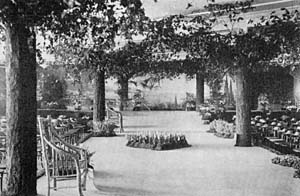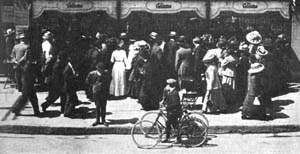It was a time of hope and of despair. A century of peace succumbed to worldwide war, and extravagance yielded to discretion. The ravages of The Great War were to spawn movements in art and literature. Wassily Kandinsky, Franz Marc and the other German Expressionists portrayed the human condition. John McCrae wrote, “In Flanders fields the poppies blow between the crosses, row on row…”
And, undeterred by global theater and international events, commercialism persevered and flourished as America continued to grow.
As the decade began, a theatrical approach to retailing was beginning to evolve. Goods were imbued with associative qualities, equating them to people, places and events. The show window was fast becoming an important tool in the retailer's repertoire. “Displaymen” used fantasy and theater to link merchandise to perceived and desired “lifestyles.” Macy's 1914 spring window extravaganza allowed customers to stroll down a promenade on the French Riviera; mannequins cloaked in luxurious evening gowns were staged in an opulent ballroom.
Arthur Fraser, of Chicago's renowned Marshall Field's, became the most prominent display director of the decade. Totally theatrical in his approach, he added drama, artistry and excitement to the retail stage. In 1913, presenting a line of merchandise inspired by Japanese tradition, he enhanced his windows with large Japanese landscapes to celebrate the theme. The Merchants'Record and Show Window wrote: “The soft, hazy tones and vague lines, with the faint, snow-capped Fujiyama in the distance, gave wonderful perspective to the whole setting.”
Marshall Field's habitually covered its show windows on Sundays, inadvertently escalating the anticipation. Thousands lined up for the unveiling of Fraser's weekly creations. As Field's entered the fall selling season of 1916, gold curtains were installed on the windows to properly introduce the latest production.
Advertisement
William Leach noted in Land of Desire that the show window had become so important by 1910 that retailers vied with one another for valuable window exposure, both above and below ground. Retailers negotiated with local municipal authorities for the rights to below-ground subway station windows – invaluable marketing tools directed toward the captive daily commuter. From Filene's subway windows on Washington Street in Boston to Philadelphia's Market Street (where Wanamakers, Snellenberg's, Lit's, and Strawbridge & Clothier all enjoyed prime station exposure), retailers were taking advantage of this new marketing venue. In Chicago, Field's and Carson Pirie Scott built underground windows. The trend also caught on in New York's new Interborough Rapid Transit (IRT) subway stops.
Retailers came to appreciate the inherent value in the “art of display” and the power of the show window, and independent manufacturers began providing them with equipment and supplies – pedestals, fabrics, decorative backgrounds and the increasingly popular mannequin. In 1911, the first abstract mannequin was presented at the “Salon d'Automne.” Inspired by the early stages of cubism, it was covered with shards of broken mirror.
The “Belle Epoque” was over. A new ethic defined the face of Western society. Europe was at war and America eventually joined the fray. As women became integral parts of the war effort, constricting wardrobes and bruising whalebones gave way to more utilitarian dress, and the idea of women as independent – as workers, voters, thinkers, executives – began to take hold.
In large numbers, European and American women were entering a work force previously dominated by men. The practical attire of the new woman had a tremendous effect on fashion. In Helen Brockman's The Theory of Fashion Design, she quotes from a 1918 issue of Vogue: “Now that women work, working clothes have acquired a new social status and chic.” Soon after the war, Coco Chanel popularized the Garçon style, with sweaters, jersey dresses and high-fashion pants for women.
New trends in fashion and the growing acceptance of “ready-to-wear” created incredible popularity for the complete mannequin, which now graced the show windows of most major retailers in America. Through whims of fancy and artistic inspiration, these almost “animate” forms focused the viewer's eyes on individual items, sparking interest, desire and enthusiasm. With elegance, attitude and emotion, mannequins soon became the star performers on retail's great stage.
Photos courtesy of ST Publications, Cincinnati
Advertisement


 Photo Gallery1 week ago
Photo Gallery1 week ago
 Headlines4 days ago
Headlines4 days ago
 Headlines1 week ago
Headlines1 week ago
 Headlines2 weeks ago
Headlines2 weeks ago
 Headlines1 week ago
Headlines1 week ago
 Designer Dozen1 week ago
Designer Dozen1 week ago
 Headlines1 week ago
Headlines1 week ago
 Headlines1 week ago
Headlines1 week ago














